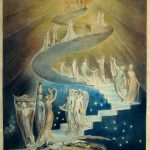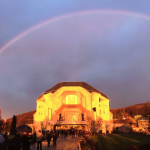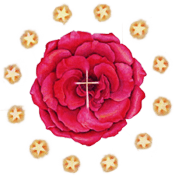Pilgrimage To Chartres
2000 Pilgrimage to Chartres and Great Britain
What is it? The phantom of a Cup which comes and goes?
Nay monk! What phantom? Answered Perceval.
The Cup, the Cup itself, from which our Lord
Drank at the last sad supper with his own.
This, from the blessed land of Aromat…
Arimathean Joseph, journeying brought to Glastonbury…
And there awhile it bode, and if a man
Could touch or see it, he was heal’d at once,
By faith, of all his ills. But then the times
Grew to such evil that the Holy Cup
Was caught away to Heaven and disappear’d.
The Dawn of a New Millennium
The Return of Christ
And the Emergence of the Divine Feminin
Chartres, France
Sunday, May 21 - Friday, May 26, 2000
Great Britain
Saturday, May 27 - Monday, July 12, 2000
There was a significant mystery center dedicated to the Divine Feminine located at Chartres in pre-Celtic times. It was widely recognized as a natural power center, where the forces of Nature were particularly strong. Through the special nature of this holy place, it was possible to experience the “Celtic Demeter” there. When Christianity became established in Chartres, it was natural to dedicate the cathedral to the Virgin Mary. The ancient holy well beneath the crypt of the cathedral was part of the original mystery center, the crypt having been a grotto in which an ancient wooden statue of the Virgo Paritura (“the Virgin who will give birth”) was housed. This statue was preserved in the crypt but is presumed to have been destroyed at the time of the French revolution in 1793. As a reminiscence thereof, reference is made to "Our Lady of the Underworld" in a prayer to Our Lady of Chartres. "From your revered crypt, our Lady of the Underworld, be always the source of grace." The existing statue in the chapel of the crypt is said to be an imitation of the original statue. On this account and for many other reasons, Chartres became the most important center in Western Christianity dedicated to Mary Sophia. With our guide, Wolfgang Larcher, who has been conducting guided tours of the cathedral for over twenty years, we entered into the Sophianic mysteries of Chartres cathedral. The following program outlines our path of exploration during the week.
The cathedral itself - with its wonderful sculpted facades and its beautiful stained-glass windows - is an expression of the mysteries of the Divine Feminine. During our week in Chartres, we explored the mysteries of Chartres cathedral together with Wolfgang Larcher, who has been guiding tours to the cathedral for many years. We walked the ancient labyrinth on the floor of the cathedral, and sang and did prayer eurythmy in the early mornings in the cathedral.
Our Sophia conference in Chartres was to honor and bring to realization something of Rudolf Steiner’s words concerning the significance of Chartres and the spiritual impulse connected with Chartres at the end of the twentieth century (and at the beginning of the twenty-first century). He pointed to Chartres and the impulse of the “School of Chartres” as being decisive at this time for humanity’s future (Karmic Relationships, vols. 3 & 4). It is for this reason that we gathered for a week in Chartres at that special moment in cosmic time.
“The great spirits of Chartres…their purpose is to prepare so that they will be able to work together in an earthly life, cultivating spirituality once more within the civilization which, apart from this, is sailing on into destruction and disintegration…They have not appeared again on earth, not at any rate the more important individualities among them. They are waiting till the end of this century.” (Rudolf Steiner, Karmic Relationships, vols. 3 & 4)
Themes that were taken up were:
From the Earth Mother to Mary: starting with the crypt, an account of the various phases in the building of the cathedral - how it grew from the original grotto to become the monumental edifice that it is now.
The cathedral and its “sheaths”—The outer architecture and the West Portal.
Chartres cathedral as a “temple” mirroring the temple of the human body. The architectural metamorphosis from outside to inside the cathedral, where the earthly downward attraction is overcome by a power of “uprightness” working from above.
The seven steps to the altar and the cosmic-musical rhythms in the structure of the cathedral. The colored windows and the experience of being “carried in light”.
The labyrinth and its significance as an image of the path of development of the human self to freedom.
Chartres is famous for its medieval school that cultivated a Platonic spirituality, Rudolf Steiner spoke of the significance of this for the end of the twentieth century. Michael Frensch, editor-in-chief of the monthly journal, NOVALIS, who has made a special study of Chartres, shared with us his knowledge of the mysteries of Chartres.
From Chartres, once Gaul's great center of Druid culture, we traveled to the British Isles, the birthplace of that ancient culture, to embark upon a "mystery journey” to the sacred sites there.
We began our two-week spiritual pilgrimage of the British Isles, starting on May 28 at Stonehenge, the great Druid mystery center of antiquity. In Britain we picked up the thread of our former pilgrimages as a search for the impulse of early Christianity, a search we have pursued not just in the Holy Land, but also in various places to which early Christianity spread. Thus, Glastonbury is said to be, as a result of Joseph of Arimathea’s visit and stay there, the place of the first Christian church in the British Isles. And, according to legend, King Arthur was buried at Glastonbury. The interweaving of the Grail stream and the Arthurian stream, also an important theme presented by Rudolf Steiner in the lectures on Karmic Relationships, was another central focus on our pilgrimage to Britain.
Together with Simon Peter Fuller, who has been guiding such tours throughout the British Isles for a number of years, we visited: Avebury - a celebrated landscape temple with a circle of standing stones and the largest man-made mound in Europe; Stonehenge - a cosmically aligned temple of standing stones, to which we had access by special arrangement; Glastonbury - with its mysterious Tor and the ancient Chalice Well, connected by legend with Joseph of Arimathea; Tintagel - according to Rudolf Steiner a site of the Arthurian knights and the magician Merlin; St. Michael’s Mount - an island fortress where a fisherman in the sixth century had a vision of the Archangel Michael.
Then, with poet Charles Lawrie, who grew up on the island of Anglesey, the last stronghold of the Druids, we visited Anglesey and the Snowdonia area of North Wales, an area rich in legend and myth. And at nearby Penmaenmawr, we visited the stone circle spoken of by Rudolf Steiner and the Russian Sophiologist, Valentin Tomberg, both of whom visited this ancient center of the Druid mysteries. From Wales, we traveled to the Lake District and visited the Castle Rigg stone circle in Keswick. Then we made the journey to the island of Iona to conclude our commemoration of the return of Christ and the re-emergence of the Divine Feminine.
This pilgrimage culminated at Pentecost on the island of Iona, a tiny island - belonging to the Hebrides - off the West Coast of Scotland. Iona was a cradle of Celtic Christianity, cultivated there in the sixth century A.D. by St. Columba, whose name in Latin means “dove”. And St. Columba, when he traveled from Ireland to Iona with a handful of disciples, is said to have arrived on the eve of Pentecost (possibly in the year 563) - Pentecost being the festival of the Holy Spirit, symbolized by the dove! At the same time, Iona is, according to a prophetic legend, a place where the Christianity of the future, a Christianity incorporating the Divine Feminine, is to arise. It is in honor of this prophecy that the Sophia Foundation of North America had its annual meditation retreat on Iona, at the special time of Pentecost.
Iona, of which it is said that "the veil between the worlds is thin!', has the soft, receptive quality of the Divine Mother and a long heritage of association with Holy Sophia. On this isle, the ancient homeland of the Celts, one can lovingly connect with the heart of the Mother and walk and sit upon rocks which are almost three billion years old. This was a time to rest and peacefully reflect upon the inspiration of the Living Christ and the enlivened Sophianic impulses that are flowing in at the turn of the millennium.
We visited the Abbey and walk the "walk of kings". We sailed across to the Isle of Staffa, formed of an upward thrust of ancient hexagonal stone columns, which reminds one of music itself. Staffa is the home of Fingal's cave, which was the inspiration for Mendelssohn's "Hebridean Overture".
We sang in the ruins of the ancient convent in honor of St. Bride, the Celtic priestess, and healer who, according to legend, brought to Iona the gifts of Brigid, the "Patron Goddess" of Ireland, who in Celtic myth is depicted with her blue mantel protecting her people.
Through meditation, walking excursions, conversation, talks and eurythmy with Robert Powell we celebrated and opened ourselves to experience the Sophianic Presence of this sacred and blessed island.
Here with some quotes relevant to our pilgrimage of Britain:
“We feel it will not be foreign to our purpose to discuss the legendary accounts of the Hyperboreans…Apollo is honoured among them above all other gods…And there is also on the island both a magnificent sacred precinct of Apollo and a notable temple…spherical in shape.” Footnote by C.H. Oldfather: “There seems good reason…to see in this people who live ‘beyond the north wind,’ as their name signifies, an early acquaintance of the Greeks, through the medium of the Celts, with Britain and its inhabitants…Apollo would be the Celtic sun-god Borvon, and the ‘sacred precinct’ of Apollo would be the famous Stone Age remains of Stonehenge.”
(Diodorus of Sicily, The Library of History, Book II, translation and commentary by C.H. Oldfather)“In the south of England, such a place is to be found at Glastonbury. It is the ancient Avalon, well-known through the story of King Arthur and his Round Table. In a beautiful garden with many roses and all kinds of other flowers, there is a very old well, the Chalice Well. Here the story is told about Joseph from Arimathea who came there after the crucifixion of Christ and poured out His Blood in the well. Since that moment the water that comes out of it has a wonderful healing power.”
(The Messenger of Chalice Well, no. 31, Easter, 1976, p. 22)“When here we climb the hills and come upon the Druid stones, which are monuments to the spiritual aspirations of those ancient times, it can be a warning to us that the longings of those people of old who strove after the spirit, and looked in their way for the coming Christ, will meet with fulfillment only when we, once again, have knowledge of the spirit, through the spiritual vision that is our way of looking for His coming. Christ must come again. Only thus can humanity learn to know Him in His spiritual form, as once, in bodily form, He went through the Mystery of Golgotha.”
(Closing words of the last lecture held by Rudolf Steiner at Penmaenmawr on August 31, 1923)“Sometimes I dream of the old prophecy that Christ shall come again upon Iona, and of that later and obscure prophecy which foretells, now as the Bride of Christ, now as the Daughter of God, now as the Divine Spirit embodied through mortal birth in a Woman, as once through mortal birth in a Man, the coming of a new Presence and Power: and dream that this may be upon Iona.”
(Fiona Macleod, Iona)
A LEGEND OF THE SOUL
The Holy Grail is represented invariably, except in one German version of the legend, as that vessel in which Christ either celebrated the Last Supper or consecrated for the first time the elements of the Eucharist. It is, therefore, a Passover or sacramental vessel and, according to the legend, its next use was to receive the blood from the wounds of Christ when His body was taken down from the cross, or alternatively, from the side which was pierced by the lance of Longinus.
From either point of view, the Holy Grail is a permanent Christian reliquary. Under circumstances which are recounted variously, the vessel, its content included, was carried westward in safe guardianship, finally coming to Britain and there remaining, either in the hands of successive keepers or in those of a single warden, whose life was prolonged through the centuries.
In the days of King Arthur, the prophet and magician, Merlin, assumed the responsibility of carrying the legend to its term, with which object he brought about the institution of the Round Table; and the flower of Arthurian chivalry - Perceval, Lancelot, Gawain, Bors, Galahad, among many others - set out to find the sacred vessel. Only a few were successful in their quest and that which followed was the removal or deeper concealment of the Holy Grail.




